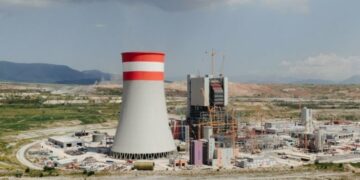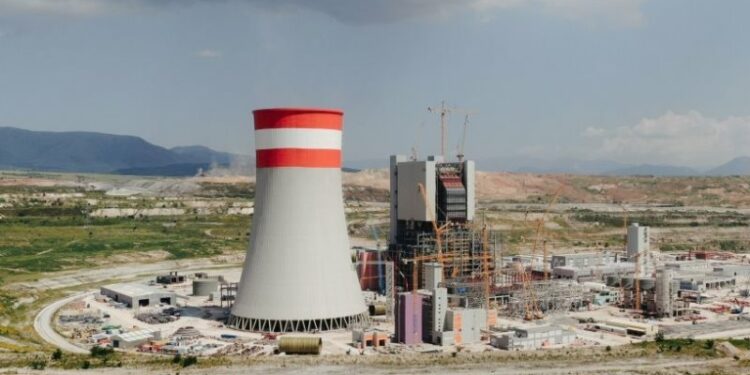Η κατασκευή της ατμοηλεκτρικής μονάδας Πτολεμαΐδα V αποφασίστηκε από τη ΔΕΗ τον Νοέμβριο 2007, επί προέδρου και διευθύνοντος συμβούλου Τάκη Αθανασόπουλου, όταν το σύστημα ηλεκτρικής ενέργειας της χώρας μας αντιμετώπιζε μεγάλα προβλήματα ελλείμματος ισχύος.
Είναι χαρακτηριστικό ότι η ζήτηση ηλεκτρικής ενέργειας το χρονικό διάστημα από 2001 μέχρι 2006 αυξανόταν με μέσο ετήσιο ρυθμό 4%, ενώ υπήρχαν πολύ λίγες ιδιωτικές μονάδες φυσικού αερίου στο σύστημα.
Η σύμβαση ανάθεσης του έργου υπογράφηκε επί προέδρου και διευθύνοντος συμβούλου Αρθούρου Ζερβού τον Μάρτιο του 2013, ενώ η κατασκευή της ξεκίνησε το Δεκέμβριο του 2015.
Πρόκειται για σύγχρονη λιγνιτική μονάδα, τη μεγαλύτερη που έχει κατασκευάσει ποτέ η ΔΕΗ, με ισχύ 660 MW, η οποία θα παράγει επίσης θερμική ισχύ 140 MW, για την υποστήριξη της τηλεθέρμανσης της πόλης της Πτολεμαΐδας.
Το συνολικό κόστος ανάπτυξής της μονάδας ανέρχεται σε 1,4 δισ. ευρώ, συν 200 εκατ. ευρώ για τα συνοδά έργα. Η μονάδα θα τεθεί σε δοκιμαστική λειτουργία το Φθινόπωρο του 2022 και εκτός απροόπτου στις δοκιμές, αναμένεται η έναρξη εμπορικής λειτουργίας στο τέλος του 2022 με αρχές του επόμενου έτους.
τελευταία δέκα χρόνια, οι αποφάσεις για την Πτολεμαΐδα V αμφισβητήθηκαν έντονα από πολλούς, εντός και εκτός ΔΕΗ, με αποκορύφωμα, στα πλαίσια της πολιτικής εσπευσμένης απολιγνιτοποίησης, την πρόταση μετατροπής της σε μονάδα φυσικού αερίου, ισχύος 1000 MW, με έναρξη των σχετικών εργασιών το 2025. Στη σημερινή συγκυρία, η έναρξη λειτουργίας της Πτολεμαΐδας V θεωρείται απόλυτα αναγκαία για την ενεργειακή επάρκεια της χώρας στους δύσκολους επόμενους μήνες.
Εκτός της προφανούς συμβολής της μονάδας στην ενεργειακή ασφάλεια της χώρας, ενδιαφέρον έχει να δούμε και η επίδραση που μπορεί να έχει στις τιμές της αγοράς ενέργειας, και ιδιαίτερα στις τιμές της επόμενης μέρας DAM (Day Ahead Market), οι οποίες εν πολλοίς καθορίζουν τις τιμές ενέργειας. Για το σκοπό αυτό χρησιμοποιούμε την πλατφόρμα DIEM (link), η οποία έχει αναπτυχθεί στο ΕΜΠ από την ομάδα Smart Rue και συνεργάτες της με σκοπό τη συλλογή και οργάνωση των δεδομένων της αγοράς ηλεκτρισμού και φυσικού αερίου που δημοσιεύονται δημόσια από Εθνικούς και Ευρωπαϊκούς οργανισμούς. Για τις ανάγκες του άρθρου, η λειτουργία της αγοράς προσομοιώνεται κατά το χρονικό διάστημα 1/1-30/6/2022, ως να είχε ενταχθεί στο σύστημα η Πτολεμαΐδα V. Η μελέτη χρησιμοποιεί το ίδιο ωριαίο φορτίο και την ίδια παραγωγή ΑΠΕ, η οποία εντάσσεται κατά προτεραιότητα στο σύστημα. Το ίδιο ισχύει και για την παραγωγή των υδροηλεκτρικών. Οι προσφορές των υπαρχουσών θερμικών μονάδων παραμένουν οι ίδιες. Το μεταβλητό κόστος της Πτολεμαΐδας V, εκτιμάται σε 100€/MWh, κόστος ρεαλιστικό, αν λάβουμε υπόψη μας ένα κόστος αγοράς δικαιωμάτων CO2 80€/τόνος, τις υψηλού επιπέδου περιβαλλοντικές προδιαγραφές της μονάδας (εκπομπές 1.05 τόνοι CO2/MWh) και τροφοδοσία της από το φθηνό ορυχείο της Μαυροπηγής. Η προσομοίωση βασίζεται στις σωρευτικές καμπύλες προσφοράς και ζήτησης, στις οποίες προστίθεται η διατιθέμενη ισχύς της Πτολεμαΐδας V, μετακινώντας ανάλογα το σημείο τομής των δύο καμπυλών καθώς και τα αποτελέσματα σε σχέση με τις προσφορές εντολών πακέτου (block order). Στη σημερινή λειτουργία της ενιαίας Ευρωπαϊκής αγοράς, ιδιαίτερη προσοχή χρειάζεται η μοντελοποίηση των ανταλλαγών ισχύος μέσω διασυνδέσεων με τις γειτονικές χώρες, κυρίως την Ιταλία και Βουλγαρία. Είναι προφανές ότι η λειτουργία μιας μεγάλης μονάδας στην Ελλάδα θα επηρεάσει και τις αγορές των γειτονικών χωρών. Για τους σκοπούς της μελέτης, υποτίθεται ότι εάν η τιμή κλεισίματος της Ιταλίας ή/και Βουλγαρίας είναι μεγαλύτερη από την τιμή κλεισίματος της Ελλάδας, ενέργεια από την χώρα μας θα προσφερθεί στις γειτονικές χώρες και προφανώς θα επηρεάσει τις τιμές τους. Υποθέτουμε ότι η ενέργεια αυτή θα προέλθει από την Πτολεμαΐδα V, ως φθηνότερη μονάδα. Για το λόγο αυτό εφαρμόζεται μια αναδρομική συνάρτηση, με την οποία αφαιρείται από την ισχύ της Πτολεμαΐδας V, η ισχύς των διασυνδέσεων όταν κάποια τιμή γειτονικής αγοράς είναι υψηλότερη και επαναυπολογίζεται η τιμή κλεισίματος της DAM.
Στο Σχήμα 1 φαίνεται η εξέλιξη των τιμών DAM, εάν οι προσφορές της Πτολεμαΐδας V ήταν 100€/MWh, σε σύγκριση με τις τιμές που σημειώθηκαν στην ίδια περίοδο του πρώτου εξαμήνου του 2022. Ο μέσος όρος της τιμής κλεισίματος της αγοράς επόμενης μέρας διαμορφώνεται από 237.05 €/MWh σε 164.77 €/MWh. Σύμφωνα με τον τρόπο λειτουργίας της αγοράς, η συνολική παραγωγή αποζημιώνεται με την τιμή κλεισίματος. Από το άθροισμα της μείωσης της τιμής ανά ώρα επί το συνολικό φορτίο της ώρας προκύπτει η μείωση κόστους αγοράς ενέργειας. Από το φορτίο της κάθε ώρας έχει αφαιρεθεί η παραγωγή των ΑΠΕ οι οποίες αποζημιώνονται στη μεγάλη τους πλειοψηφία με ειδικές τιμές (feed in, feed in premium tariffs). Για το εξάμηνο 1/1-30/6/2022 η μείωση προκύπτει ίση με 1.35 δισ€ περίπου. Σημειώνουμε ότι η μείωση αυτή είναι προσεγγιστική και είναι η μείωση του κόστους αγοράς ενέργειας από τη DAM και όχι κατ’ ανάγκη αύξηση της οικονομικότητας του Συστήματος.
Ανάλογα συμπεράσματα μπορούμε να βγάλουμε και αν η προσφορά της Πτολεμαΐδας V ήταν 125 €/MWh (Σχήμα 2). Στην περίπτωση αυτή ο μέσος όρος της τιμής κλεισίματος της αγοράς επόμενης μέρας διαμορφώνεται σε 177.22 €/MWh, το οποίο συνεπάγεται μια μείωση κόστους αγοράς ενέργειας για το εξάμηνο κατά περίπου 1.13 δισ€.
Σχήμα 1. Σύγκριση ωριαίων τιμών κλεισίματος αγοράς επόμενης μέρας (DAM) χωρίς (καταγεγραμμένες) και με τη λειτουργία της Πτολεμαΐδας V (εκτιμώμενες) με προσφορά 100€/MWh
Σχήμα 2. Σύγκριση ωριαίων τιμών κλεισίματος αγοράς επόμενης μέρας (DAM) χωρίς (καταγεγραμμένες) και με τη λειτουργία της Πτολεμαΐδας V (εκτιμώμενες) με προσφορά 125€/MWh
Είναι προφανές ότι η ένταξη της Πτολεμαΐδας V θα συμβάλλει σημαντικά στην ασφάλεια τροφοδοσίας, δεδομένου ότι βασίζεται σε ένα εγχώριο και ελεγχόμενο καύσιμο, αλλά ότι μπορεί να επηρεάσει και την οικονομικότητα λειτουργίας του Συστήματος. Ακόμα και μετά την πάροδο της παρούσας ενεργειακής κρίσης, θα πρέπει να μελετηθεί με προσοχή ο ρόλος μιας τέτοιας μονάδας στη μακροπρόθεσμη ασφάλεια του Συστήματος στα πλαίσια ενός μακροχρόνιου ενεργειακού σχεδιασμού. Αυτό βέβαια δε σημαίνει ότι η παρούσα ενεργειακή κρίση θα πρέπει να οδηγήσει σε αντιστροφή της πολιτικής της ενεργειακής μετάβασης, η οποία θα οδηγήσει σε μια νέα κρίση, περιβαλλοντική αυτή τη φορά. Η δίκαιη μετάβαση σε ένα ενεργειακό σύστημα που βασίζεται στην πλήρη ανάπτυξη των ΑΠΕ δεν παύει να αποτελεί μονόδρομο.
Νίκος Χατζηαργυρίου, καθηγητής ΕΜΠ, πρώην αντιπρόεδρος της ΔΕΗ
Αρης Δημέας, Δρ. ΕΜΠ, Κύριος Ερευνητής Smart Rue































